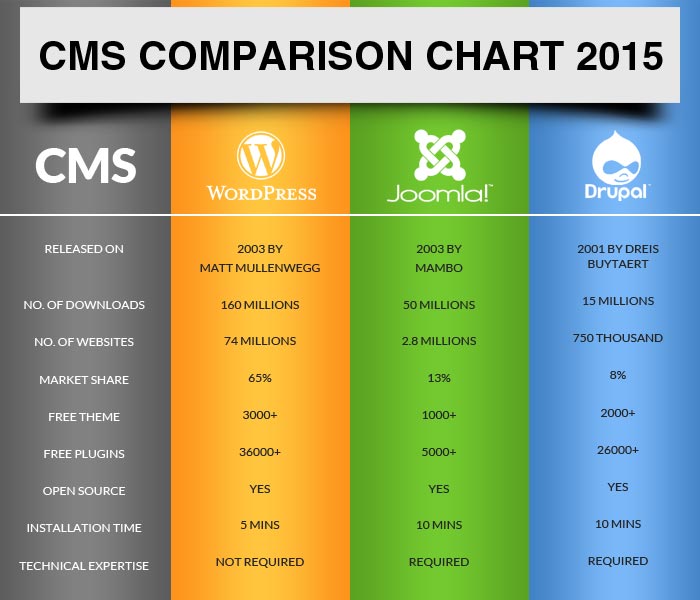 CMS (Content Management System) are simple and yet feature rich platforms that are used for developing websites and web applications. Three of the world’s most popular and highly used CMS platforms are WordPress, Joomla and Drupal. They are open-source and used by millions across the globe. Let’s compare the three leading Content Management Systems and figure out how each of them stands against each other.
CMS (Content Management System) are simple and yet feature rich platforms that are used for developing websites and web applications. Three of the world’s most popular and highly used CMS platforms are WordPress, Joomla and Drupal. They are open-source and used by millions across the globe. Let’s compare the three leading Content Management Systems and figure out how each of them stands against each other.
WordPress: One of the most used Content Management Systems WordPress was released in the year 2003 by Matt Mullenwegg. Today with close to 160 million plus downloads more than 70 millions websites run on this platform. With stiff competition from other competitors like Drupal and Joomla, WordPress still holds a lion’s share of about 65% in the open source CMS segment. Started solely as a blogging platform today WordPress is used to build innovative websites and applications. WordPress offers more than 3000 plus themes and more than 35000 plugins this more than what Drupal and Joomla offering. One of the best things of WordPress is it does not require technical excellence to implement it the basic understanding of the CMS will suffice. Some of the best known sites developed on WordPress include TechCrunch, Mashable, CNN etc.
Advantages of WordPress
1. Its user-friendly
2. Seamless integration of third-party SEO Plugins
3. Responsive Themes
4. Robust Support
5. No technical expertise need
Disadvantages of WordPress
1. Prone to attack
2. Website speed can fluctuate
3. Compatibility with WordPress update
Joomla: The second most used CMS after WordPress, Joomla has gained market dominance in recent. Joomla was released in the year 2003 by Mambo and till date it has been downloaded 50 million times and nearly powers close to 2.5 million websites worldwide. Joomla commands a substantial market share of 13% which is more than Drupal but way less than Drupal. Joomla boast of 1000 plus free high quality themes and 5000 plus great plugins to offer higher degree of flexibility. Just like WordPress and Drupal Joomla is a open source CMS and the updates are released in every 36 days to make the ecosystem more robust and bug free. Joomla unlike wordPress needs a certain degree of technical expertise to build your website and applications. Having said that it is less complex than Drupal and with fair of technical know-how Joomla can do wonders for developers. Website of Linux, IKEA, and Harvard University are built using Joomla CMS.
Advantages of Joomla
1. Robust and User-friendly admin UI
2. Large developer community to offer support
3. Great for developing E-commerce sites.
4. Hundreds of extensions offer great flexibility.
5. Seamless migration between servers
Disadvantages of Joomla
1. Plugins compatibility is an issue
2. Steep learning curve
3. Increase website load time
Drupal: In the series of top 3 free Content Management Systems Drupal commands a niche and highly defined market. Released in 2001 by Dreis Buytaert Drupal has stood test of time and is one of the oldest and most used open source CMS. It has been downloaded more than 15 millions time and it powers more than 700 thousand websites. Due to its steep learning curve and need of higher degree of technical expertise it commands only 8% of market share which is less compared to WordPress and Joomla. It has more than 2000 themes and 25000 plugins these numbers are greater than Joomla but less than WordPress. Developers looking to develop complex and advance website or web application rely on Drupal for its sheer brilliance in handling heavy data and other complex functions. Of all three CMS mentioned here Drupal requires high level of technical expertise to work on. This had made it less popular among developers who look for something simple and easy to work on nevertheless it command high respect in terms advanced features. World Bank, MTV UK, Grammy Awards, AOL Corporation website, Fast Company, Capgemini websites are powered by Drupal CMS.
Advantages of Drupal
1. Supports multi-site
2. Offers great scalability
3. Easy management
4. Excellent content creation
5. Robust admin controls
Disadvantages of Drupal
1. Steep Learning curve
2. Limited number of developer community
3. Compatibility issues
One can choose any of the three open source Content Managemnet Systems depending on their needs and preferences.



